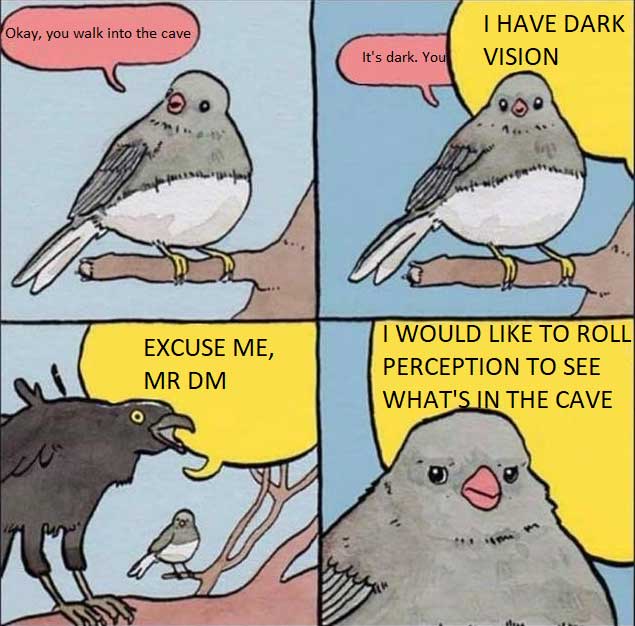You're using Darkvision wrong

If you've played previous editions it can be frustrating having a dark and spooky dungeon in 5th edition as your players frequently remind you that they have darkvision. In previous iterations of D&D, darkvision was much rarer (in 3e only dwarves and half-orcs had it) and low-light vision was the more common one, which merely doubled the range of light sources. You might feel like you can't have dark places be interesting anymore, but there's an important caveat that you're missing.
Darkvision can't discern color, and changes darkness into dim light. Dim light means you have disadvantage on perception checks (unless you're using something like smell) and a -5 to your passive perception. That's a pretty big limitation that many DMs and players ignore.
Players have disadvantage on Perception checks and -5 to passive perception when trying to see hidden enemies. All cave-dwelling critters in the real world use stealth to avoid detection, and your D&D creatures should as well. A hidden creature only needs cover and to beat the target's passive perception in order to remain undetected (and get a free surprise round), which is much easier when their modified passive perception is only a 9. Even if detected by one of the party, that only means that player will be able to act in the first round of combat and the enemies won't have advantage against them specifically. Fortunately, there are other targets in the party that are still stumbling in the dark.
Darkvision reliant players have disadvantage/-5 to spot traps. Ancient machines and simple tripwires become all the more dangerous when placed in the dark. Your trap might also extend beyond 60 feet, like a long corridor full of tiny holes in the walls (with darts) that's disarmed by hitting the bullseye at the other end. If your party is full of darkvision and ignores light, you can also try putting in a couple puzzles that rely on color. They should at least carry a torch after getting stumped for a while by a puzzle where they have to put colored stones in the order of a rainbow.

If the party can see a room, but the details are dark and hazy, they can't see any of the hidden enemies, and they can't spot any traps, then they can't really see the room can they?
Dungeons can still be spooky and combats can still be interesting in a group with a lot of darkvision. If you play on a virtual tabletop you can set an aura on each token to signify darkvision and torch range, or in person you can cut a 40 foot template with a 20 cm (8 inch) radius circle for torches and a 60 foot template with a 30 cm (12 inch) radius for quick reference. When drawing your dungeon, make good use of corners to obscure vision and space your rooms at least 60 feet apart.
For combat, try some more wide open areas instead of cramped corridors. Imagine a huge open cavern over 200 feet across that's complete darkness. This could make for an interesting combat where enemies come from all around, hiding beyond the range of their vision before dashing in from all angles. You can effectively consider the edge of most of the party's vision as cover (there's always that one warlock) when planning your moves, which can allow for a lot more flexibility when designing encounters.
With those tricks, you have plenty of opportunity to make deep dark dungeons feel deep and dark again. With a lot of rules in D&D you have to actually engage with and use the rule to see the most benefit from it. In the case of darkvision, actually checking and making use of ranges, and imposing the limitations of it, helps keep the rule fun and interesting instead of overpowered and forgotten about.
Need more help with your campaign? Check out all the other tools, generators, and articles: https://www.kassoon.com/dnd/
Shout outs: Stacey, Adam Fowler, Amanda Kettles, Angelo Anderson, Appreciate Witch of Life, AstroLass, bilbens baggo, Brian Nunziato, Bryan Sheairs, Brysen Packer, Bryson Waits, Burlyfighter, Caitlin W., Christopher Allbritton, CJMAXP, Connor, Dalton Elliott, Damon Carrington, Daniel Edwards, David Schraff, Dragons With Jetpacks, Elisa Martinez, eric sun, Ezzela1891, Federica Frezza, Gordon Alexander Fallon, Gundar Wez, Iofire, Irate The Pirate, Jade Arrowood, Jake Lane, Jeremiah Walker, Jess, Joe Dalby, John Nazario, JollyGamer, Jonathan Lekse, Jordan Brazeal, Joshua David Maddox, Justin Snyder, Kerry Melton, Kevin, KFB_Patreon, KingHavok1217, Kingyo Senpai, Kyle Clark, Lisa Tucker, Liz Fontain, Lizzie, Lou Bliss, Luke P, Mario Pizzamiglio, Mark L, Matt Yates, Max Hops, Maxwell Mayer, Michael Hamilton, Millergendraft, mtnman1979@aol.com, Mx Charlie, Mylon Schroder, Nahellion, Nathan, Nicholas Zamora, Nick Soucy, Phil Mehl, Phillip P Torchia, Pythor Sen, R., Rachel Anderson, Ray Bissonnette, Remora Jewel, Robert Rich, Robert Skadsem, Ryan Flagg, SallySparrow132, Sarah Holland, Serafina Moon, Shane Andrews, ShortyMcgibble, Sik Makoyi, Siren, Stefan Gottschalk's, Steve Rosenlund, Stuart, Syn21, That Video Editor Nic, thea musing, Trev909, Vedie V, Vincent Drone, Warren Clarida, Wesley Muncy, XMrMonkyx ., Zachary Burgess-Hicks, zachary gee, Zealot23, Zee Livezey
Their contribution stands as a beacon of hope for all adventurers!


